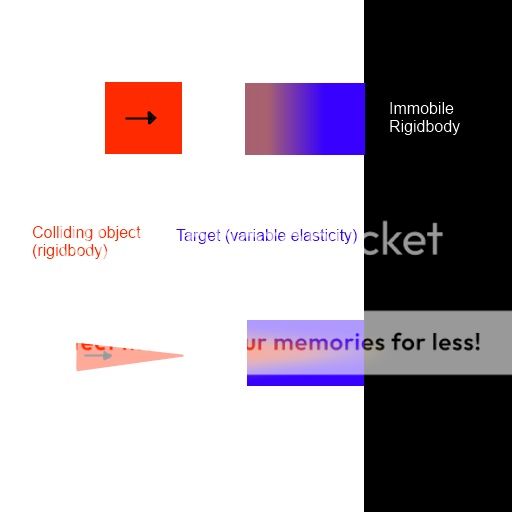SmallTownGuy
Then perhaps you should rephrase it as a golf club hitting a compressible golf ball?
The short answer is that the golf club slows down, the golf ball speeds up, and the total momentum is conserved. Whether kinetic energy is also conserved depends on whether the ball's compression is lossy.
The longer answer is that the forward pressure on the ball compresses the ball in proportion to its Young's modulus. The ball's center of mass accelerates in proportion to that pressure / its mass. Just integrate over the few milliseconds of the impact, and you'll get the ball's motion. I can't tell you more detail without knowing how lossy the ball's compression is.
Young's Modulus is something I've been looking at, and it's the main variable between targets.
The other site tossed f=ma at me, but I don't see that working. It might be approximately correct for something where the whole of the target is being accelerated at a rate with negligible variance.
But imagine a sword striking a rubber replica of the Great Wall of China. The only part of the wall that's going to make a great deal of difference is what's in the immediate striking area. Common sense tells me that the sword is going to get a nice chop into it regardless of the wall's mass a mile away.
As a sword travels, it begins to apply strain to the target in a very concentrated area, and intuition tells me that it will continue traveling and applying strain, while the stress of the immediate area tries to decelerate it. The rubber would quickly reach the fracture point of its stress/strain relationship, splitting to the sword's motion.
The point where the rubber stops the sword is where the stress has finally decelerated the sword enough, leaving it stuck somewhere inside the rubber.
Contrast this with the real Great Wall of China, where a sword might scratch it but make very little progress, due to a much higher modulus of elasticity.
Perhaps f=ma might apply somehow, but I'm not sure I envision much of a difference between a mile-long wall and a 1000-mile-long wall. As I see it, the sword would make a pretty similar strike either way. This is why I think it's more from the immediate stress than the mass itself.
 100
100
 250
250
 500
500


